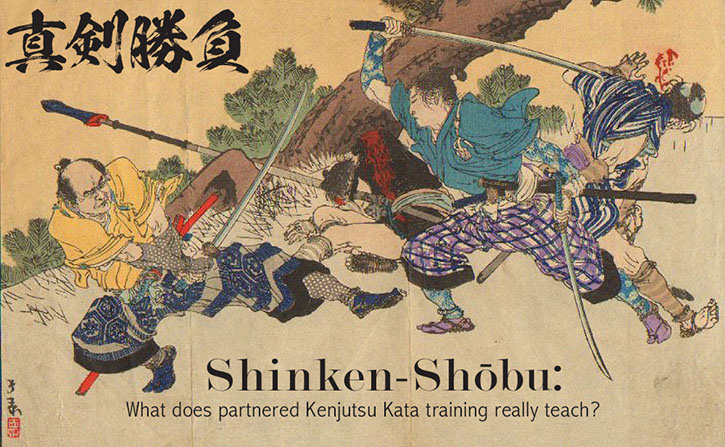|

In the historical context of traditional Japanese swordsmanship, exponents had to assume there would come a time when they were to be directly faced with life-and-death. And they came to understand that the only way to deal with this is to practice it.
In that regard, the aim of practice is to experience a serious-style (shinkengata) matter of life-and-death, and there is no other way but to rely on a repetitious Kata training process involving Uchidachi and Shidachi. That is the primary method used in classical Japanese swordsmanship (Koryū Kenjutsu).
What then are we pursuing by doing such Kata training?
It's easy to think that the purpose of Kata training is only a matter of winning or losing, or is just the pursuit of winning in the matter of life-and-death. Some might also think that the Kata training itself is merely a matter of learning and remembering the Kata.
Misconceptions like these often accompany the thinking that a larger number of Kata learned is better than a smaller number. But that is to also think that the powerful always defeats the less-powerful in swordsmanship, the higher grade or mokuroku will always beat the lower, and that the use of dual swords will always win over a single sword.
However, a certain truth exists in the matter of real life-and-death combat between opponents, and that is there are no guarantees and no rules.
Often, another misconception is that it's really a matter of learning to win with the relevant techniques being taught within the Kata, thereby placing great importance on which School's Kata has the most techniques or has the ultimate "secret" techniques. But no matter how many techniques you have learned in practice or the number of Kata you have been taught, it should be a given that there is still no guarantee you would survive in any real life-and-death combat.
Even today some Japanese Shihan still continue to remind us of the axiom that there is always going to be someone who is more adroit than you are. Therefore, the number of Kata learned, be it large or small, has little meaning from the perspective of winning in Shinken-Shōbu. Further, there are no “secret” techniques that will ensure survival in combat just because you've learned and practiced them.
In such serious circumstances as life-and-death combat, it may not even be possible to apply what you have practiced and learned given there are no rules in Shinken-Shōbu. Rather, we should learn from those who successfully traversed that thin line between life and death — the old Sword saints (Kensei) — who admonish us to pursue, by doing Kata training, the ultimate teaching (Gokui): to always be flexible, spontaneous, and free from disturbance.
So what do we ultimately learn through the Kata?
From the perspective of the Kata in the training process, what you acquire is through the Kata and not the Kata themselves. They're the vehicle, and should not be confused with the cargo. It is said that we can only acquire the things of no-shape (mukei), like Bu-no-Seishin, through things with shape or form.
In the old method of learning the techniques within the Kata, through the serious-style of partnered training, it is also taught that the last thing to learn is not the actual techniques or principles themselves, that there is always something higher than that.
Therefore we must practice to train our movements and mind, and our attitude towards the Kata to be serious, as if on the brink of life or death. Only then can we arrive at the point where we have no doubt that what must be obtained through the Kata is not only the skills and courage to face death, but also the seishin aspect of Shinken-Shōbu.
Growing older is unavoidable and life is a challenge against the ageing of each person, and ultimately it is Shinken-Shōbu with yourself. In the end, no matter how long we live we will each confront that inevitability. It could be said that through the Kata we're seeking to always face death, learning how to die with dignity, and, as part of that process, developing as a human in life and society (Ningen Keisei).
In other words, seishin is something that each of us should acquire by ourselves and it is not something that can be directly taught. Ultimately, what one learns and acquires through Kata training depends on their own intentions and mindset, doubts and the important questions that one seeks to ask of themselves. No part of this material may be reproduced in any form or by any means, electronic or mechanical, including photocopy, without permission in writing from Kobudōkai Australia. However, you are welcome to share a link to this article on such social media as Facebook, Instagram or Twitter.
~~~~~~~~~
Shinken-Shōbu (真剣勝負, lit: win-lose by live sword) is combat to the death.
Seishin Chokudō (誠心直道) – a simple, yet meaningful, phrase intimately connected with the teachings of Miyamoto Musashi, and a favourite of my Niten Ichi-ryū teacher Iwami Toshio sōke. It means a "sincere mind" and a "straight path".
|

